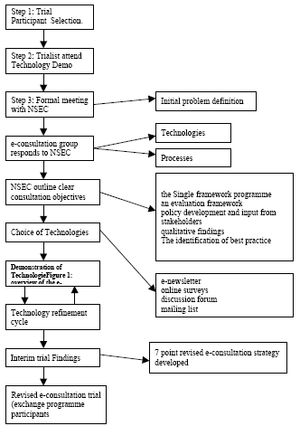NSEC E-Consultation Process and Planning
This page outlines how NSEC began to plan the implementation of their North-South Exchange programme.
Contents
Objective: A framework to manage the consultation complexity
The research team worked alongside the NSEC team. The agreement to formally work together was only arrived at after a fairly long period of discussion and clarification of the needs of both parties.
A key research objective of the NSEC trial was to develop an e-consultation framework that could mirror the complexity of the consultation objectives set out by NSEC.
Underpinning different levels of Engagement
Rather than set out to achieve a single consultation exercise, the NSEC remit was to develop an e-consultation framework that was capable of underpinning different levels of engagement with a diverse number of stakeholders.
On one hand, there was the policy arena, which concerned such issues as future development of North South exchange programmes, and on the other, there was an ongoing need to evaluate existing exchange programmes in order to provide feedback to programme designers.
The stakeholders most likely to be targeted in the trials were identified as:
- programme coordinators
- educational managers
- schoolteachers
- school children
NSEC were interested in consulting with people who had participated in North South exchange programmes and those who had not.
Key Issues
In the series of meetings with NSEC, two key points worth noting arose:
- The need for a clear understanding of the consultation aims. While the NSEC brief was to consult widely, it was difficult to ensure that the aims of each individual consultation process were clarified.
- The need for a clear understanding of the potential of available technologies. The NSEC management team had to attend several public forums and technology demonstrations before either party committed to a joint trial.
Planning
Following NSEC and the research team's agreement to formally work together, the planning phase began.
Planning Process
The overall planning process can be viewed as a flow chart (thumbnail right). The planning and e-consultation development process steps are also summarised below:- Participants are selected
- Trialist attend technology demonstration
- Research team have formal meeting with NSEC. This led to initial definition of a problem
- The e-consultation research group responds to NSEC. Technologies and processes are discussed.
- NSEC outline clear consultation objectives:
- The Single Framework Programme (SFP)
- An evaluation framework
- Policy development and input from stakeholders' (qualitative) findings
- The identification of best practice
- Technologies are chosen: E-newsletter; online surveys; discussion forum; and, mailing list
- Technologies are demonstrated
- Technology refinement cycle
- Interim trial findings produced. A 7 point revised e-consultation strategy is developed
- E-consultation trial is revised
Planning Outcomes
The outcome of the planning phase was a list of the e-consultation objectives agreed by both NSEC and the research team.
It was agreed that the trial should focus on the following five objectives:
- To obtain stakeholders’ views on the Single Programme Framework (SPF) and to ask stakeholders if they believe its proscribed themes and criteria were correct.
- To evaluate exchange programmes and to devise ways of optimising the benefits gained from these activities not only for the actual participants but also for the schools that were involved.
- To gather input from stakeholders (3,000 local groups and 18 management bodies) for policy development.
- To capture the attitudes and expectations of young people, teachers and youth workers. (This process had already started with the publication of the quality research study entitled “In their own words” by NSEC and it was hoped to make this type of activity ongoing).
- To identify best practice.
